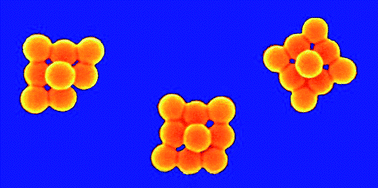Planar submicronic silica–polystyrene particles obtained by substrate-directed shaping
Abstract
Original planar biphasic colloids are obtained by (i) using a

Maintenance work is planned for Wednesday 1st May 2024 from 9:00am to 11:00am (BST).
During this time, the performance of our website may be affected - searches may run slowly and some pages may be temporarily unavailable. If this happens, please try refreshing your web browser or try waiting two to three minutes before trying again.
We apologise for any inconvenience this might cause and thank you for your patience.
* Corresponding authors
a
CNRS, Université de Bordeaux, Institut de Chimie de la Matière Condensée de Bordeaux, 87 avenue du Dr Albert Schweitzer, F-33608 Pessac, France
E-mail:
duguet@icmcb-bordeaux.cnrs.fr
Fax: +33 540 002 761
Tel: +33 540 002 651
b CNRS, Université de Bordeaux, Centre de Recherche Paul Pascal, avenue du Dr Albert Schweitzer, F-33600 Pessac, France
c Chimie, Catalyse, Polymères, Procédés, C2P2/LCPP-UMR 5265 CNRS/CPE/UCBL, 43 boulevard du 11 Novembre 1918, F-69616 Villeurbanne, France
d Université de Bordeaux, CNRS, Chimie et Biologie des Membranes et des Nanoobjets, avenue des Facultés, F-33402 Talence, France
Original planar biphasic colloids are obtained by (i) using a

 Please wait while we load your content...
Something went wrong. Try again?
Please wait while we load your content...
Something went wrong. Try again?
A. Perro, D. Nguyen, S. Ravaine, E. Bourgeat-Lami, O. Lambert, J. Taveau and E. Duguet, J. Mater. Chem., 2009, 19, 4225 DOI: 10.1039/B901901D
To request permission to reproduce material from this article, please go to the Copyright Clearance Center request page.
If you are an author contributing to an RSC publication, you do not need to request permission provided correct acknowledgement is given.
If you are the author of this article, you do not need to request permission to reproduce figures and diagrams provided correct acknowledgement is given. If you want to reproduce the whole article in a third-party publication (excluding your thesis/dissertation for which permission is not required) please go to the Copyright Clearance Center request page.
Read more about how to correctly acknowledge RSC content.
 Fetching data from CrossRef.
Fetching data from CrossRef.
This may take some time to load.
Loading related content
